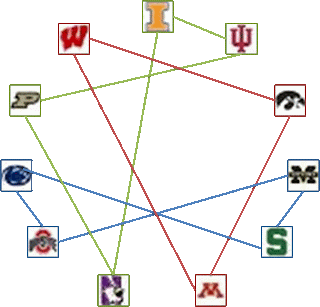The basic idea, as seen on mgoblog, The Only Colors, Sean Keeler's DMR blog, etc...is that the Big Ten will go to 16 teams with 4 division of 4 teams each. The general idea of added teams is 5 from the mix of Pitt, Rutgers, Syracuse, Nebraska, Missouri, Kansas, and Notre Dame (and some even have Texas, Texas A&M, other Big East teams, and pretty much any other team you can think of). For my purposes I'm sticking with Pitt, Rutgers, Syracuse, Nebraska, and Missouri because that seems to make sense and works out pretty well when splitting up divisions.
New Big Ten Divisions
There are plenty of different ways to split up division: geographically, "balanced", by rivalries, random, etc... Call me a traditionalist, but to me the divisions should try to preserve the great rivalries that have existed in the Big Ten for years. Here are the current protected rivalries in the Big Ten:The protected rivalries naturally form 3 distinct groups. In case you didn't notice, I color-coded those groups.
- Red is Iowa, Wisconsin, and Minnesota
- Blue is Michigan, Michigan State, Ohio State, and Penn State
- Green is Illinois, Northwestern, Indiana, and Purdue
| Division A | Division B | Division C | Division D |
|---|---|---|---|
| Iowa | Illinois | Ohio State | Penn State |
| Wisconsin | Northwestern | Michigan | Pittsburgh |
| Minnesota | Purdue | Michigan State | Rutgers |
| Nebraska | Indiana | Missouri | Syracuse |
I realize there are some problems with this arrangement, namely the ridiculously terrible Division B, but I think it does a good job of preserving the rivalries without having protected games outside of your division. And, most importantly in my mind, it creates the super awesome division of Iowa, Wisconsin, Minnesota, and Nebraska.
How 16 teams works
There are lots of options here. The simplest would be grouping the divisions together and essentially have two 8-team division where the winners would play in a championship game; or have the winners from each division play a 4-team playoff to determine the conference title. To me, the 4-team playoff makes the most sense.My thought for the end of the season is to take the teams in each division and match then up with a corresponding team in another division based on what place the teams finish. So all the first place finishers would play in the 4-team playoff, but at the same time the 2nd place finishers would face off, etc... To determine who plays who, you could rotate the divisions. The 2nd, 3rd, and 4th place finishers would not have a playoff though, just 1 game.
Okay, I'm probably not explaining it well. It would look like this:
- 1st Place Finishers: A vs B, C vs D (Winners play in Championship Game)
- 2nd Place Finishers: A vs C, B vs D
- 3rd Place Finishers: A vs D, B vs C
- 4th Place Finishers: A vs B, C vs D
To determine the winner of each division (and 2nd, 3rd, 4th) I would use: conference record, head-to-head, division record, then overall record. If you still have a Texas, Oklahoma, Texas Tech situation use strength of schedule or BCS ranking or any of those other not-so-good methods.
If we apply this loosely to last year the year-end games would have been:
- 1st Place Finishers: Iowa vs Northwestern, Ohio State vs Pitt
- 2nd Place Finishers: Nebraska vs Michigan State, Purdue vs Penn State
- 3rd Place Finishers: Wisconsin vs Rutgers, Indiana vs Missouri
- 4th Place Finishers: Minnesota vs Illinois, Michigan vs Syracuse
Pros:
- In theory this should produce good season ending games with teams evenly matched and vying for bowl position.
- The 4-team playoff especially would draw a lot of attention.
- It seems pretty fair...win your division and get in the mini playoff.
- A weak division means a team like Northwestern gets in the playoffs.
- Three of the conferences "best" 4 teams all lose their last game of the year, which will probably equate to less teams in BCS bowls.
- There is the potential for a lot of rematches.
- Only 3 OOC games, means potentially less home games and less "gimme" wins, reducing some teams chance at making a bowl.
There is probably a lot more pros and cons to this method and probably a lot more thought that would need to go into it to make it work. But it is what makes sense to me, at least for now. Let me know what you think in the comments and chime in with your own ideas too.
